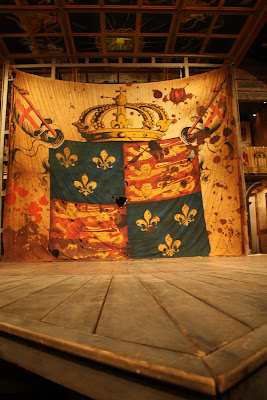The original Globe Theatre burnt to the ground in two hours in 1639 during a production of Henry VIII, when a spark from a real cannon caught the thatched roof. It was director Sam Wannamaker’s idea to recreate the theatre and he used a number of influential patrons and innovative initiatives (36,000 red bricks at a cost of £5 each were sold as fundraisers) to realise his dream.
The theatre is built to be as an exact replica as possible, based on written and visual sources (which also inform our knowledge of the behaviour and activities of theatregoers). The twenty-sided building is made out of 1,000 oak trees, held together with wooden pegs. The pillars on stage are also oak, painted to look like fake marble, and the thatched roof is the first in London since the Great Fire (thatched roofs were banned in 1666).
External gates feature 125 flora and fauna from Shakespeare’s plays while affording great glimpses of modern and ancient London. By rights the floor should be crushed hazelnut shells, cinder and ash to complete the authenticity, but this would be too uncomfortable. You can, however, still purchase food, wine and cushions to enhance your appreciation of the play.
The courtyard is open to the elements so punters will get wet or sunstroke depending on the weather (I saw a standing audience member faint from the heat, but that probably wasn’t too typical for London). The groundlings can still stand for £5, which is an amazing bargain. The stage is so close to the audience that the actors can see individual faces (there is minimal lighting used in keeping with the original atmosphere), which can be quite daunting to some. Four doors on the lower level facilitate entrances and exits, and the actors often walk among the crowds.
3,000 people used to pack into the theatre, although concerns for modern health and safety legislation (not to mention personal space) now stipulate that it holds a maximum of 1,500. No microphones are used either, although there are live musicians – the shape of the building provides excellent acoustics. While the shape of the stage can change for an individual production (using walkways, thrusts and a central platform), wall hangings are preferred to a fixed set – the setting is in the text; it is up to the audience to listen and use their imagination.
Theatrical convention meant that Heaven was above and Hell below (a trapdoor enables actors to descend and emerge) and the stage itself is meant to represent Earth. The tiring house behind the stage wall is the area where the actors got dressed (or put on their attire); the boxes were gentlemen’s rooms; the musicians’ galleries were immediately above the stage (and still are); whereas other galleries here were the Lord’s rooms – they could hear but not see the action, although they were mainly designed for them to show off their finery. Fifteen plays were written specifically to be performed at The Globe, with all its trappings and theatrical devices in mind.
The Globe had to be outside the city walls to conform to the laws of the Puritans. The locale was full of playhouses, brothels, taverns, bear-baiting, cockfighting, pleasure gardens, prisons, and inns, creating an interesting mix of culture, art, vice and dissipation. Shakespeare used many of these types, to populate his plays with credible characters. London Bridge was the only bridge across the Thames (which was three times as wide) in those days. To signal to theatregoers that a show was imminent, a flag would be raised that could be seen from the other side of the river. The performances began at 2pm and lasted for two hours with no interval; they spoke faster then as the audience were used to the style of speech.
Now actors at the Globe are contracted for 3-6 months. At least four Shakespeare plays are produced per season and new writing is welcomed. This is the ultimate venue for seeing a traditional Shakespeare play and getting a feel for the bard as he would have been performed. Alternative twists are also introduced; plays would have been all-male productions so it is no surprise that recent performances have included men-only versions of Antony and Cleopatra and Twelfth Night, although the all-female performance of Richard III would have been interesting!







3 comments:
Fascinating stuff! Thanks for the behind-the-scenes tour, Kate.
When you had your repeat visits to the Globe last year did you wander round the corner to the Rose (the first Bankside theatre)? I was in London yesterday and went for a walk down some side streets to escape the crowds at Borough Market and came across the original site to the Globe and then just the other side of the road the Rose (next to Bear Gardens...as I guess you know Southwark used to be the venue for all leisure not deemed suitable for the City). The Rose was open...it was a cross between a community project and a museum. There were about 20 chairs set up on front of a screen which showed a very good brief history of the theatre and how it was partially excavated in 1989, before being built on again. The excavated remains are now covered with water to preserve them and sit below a huge new office block. It was the most rewarding by accident find I have had in London for a long time.
I love those accidental rewards!
I am saving the Rose for my next visit and looking forward to it. Thanks for the top tip.
Kate x
Post a Comment